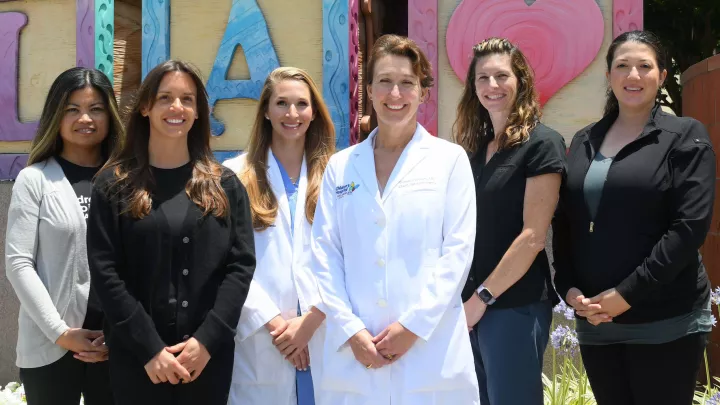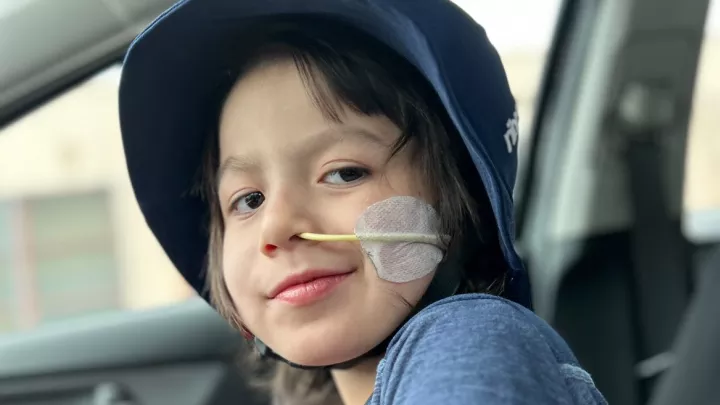
DJ holds his arms aloft as if signaling a touchdown. Most observers couldn't tell which arm was damaged at birth.
A Unique Surgical Duo Repairs a Newborn’s Brachial Plexus Injury
When Rachel began the long ride north from her home in San Diego to Children’s Hospital Los Angeles, she hardly knew the urgency of the drive.
Months earlier, her infant son, DJ, had been diagnosed with a brachial plexus birth injury, damaging the group of nerves called the brachial plexus that winds from the neck to the arm. The injury occurs during childbirth when that nerve cluster gets stressed—pulled or stretched, or, worse, torn.
“They brought him to me and his arm was like a noodle,” Rachel says. “Zero control, zero movement. It was just hanging.”
The specialists at Rachel’s local hospital advised caution, as brachial plexus birth injuries can heal on their own. “They said, ‘Let's see what regenerates naturally,’” Rachel says. “’Do these exercises in the meantime.’”
Rachel abided by the treatment plan for nine months, which tasked her with doing arm stretches with DJ six times a day and fastening him with braces and straps while he slept. Yet the arm made only moderate gains, until finally Rachel questioned doctors’ wish to inject Botox into DJ’s pectoral muscle to freeze the working area of his left shoulder and make the weaker part do more work, then cast the arm at a 45-degree angle.
That all sounded too extreme and iffy to Rachel and her husband, Philippe. “We didn’t fully understand how it would help,” she says.
Plus, there had been no mention of the most serious factor of all. The deadline for doing an effective surgical repair of a birth brachial plexus injury—the first year of life—was about to expire. When Rachel came to CHLA for a second opinion in August 2022, DJ was 11 months old.
Rewiring the arm
The moment Rachel arrived with DJ at the Brachial Plexus and Peripheral Nerve Program at Children’s Hospital Los Angeles, she instantly felt more secure.
“They did a four-hour assessment on him,” she says. “It was grueling, but it was apparent how much more experience and expertise everyone had. Within four hours they told me more about what was going on in DJ’s body than I had been told in nine months.”
The assessment showed that the brachial plexus injury DJ had suffered, classified as Erb’s palsy, had ruptured cervical nerves C5 and C6, which control mainly biceps, shoulder and elbow function. A nerve test rated the strength in both the biceps and shoulder as a 2 on a scale of 7.
CHLA orthopedic surgeon Erin Meisel, MD, co-Director of the Brachial Plexus Program, told Rachel that the best chance at giving DJ a fully functioning left arm was a nerve transfer surgery, in which parts of motor nerves that are working are transferred over to step in for nerves that are not.
“We have to rewire the arm,” Dr. Meisel says. “We’re unplugging the muscles that are not getting nerve input and plugging them into a new power source.”
To revive those incapacitated muscles, nerve parts would be taken from the trapezius, wrist flexors and the medial pectoral and relocated to charge up, respectively, the rotator cuff, the biceps and the deltoid. “Two for the shoulder, one for the elbow,” Dr. Meisel says.
She also communicated to Rachel that there was little time for deliberating, as DJ was about to turn 1 and would soon age out of being a candidate for the procedure.
“She didn't make it feel like it was an emergency,” Rachel says, “but she was clear that we needed to do this now.”
Dance partners in the OR
DJ’s surgery was aided by the participation of CHLA Chief of Neurosurgery Susan Durham, MD, MS, co-Director of the Brachial Plexus Program, who joins Dr. Meisel on brachial plexus procedures.
Their partnership is a rarity as brachial plexus repairs are usually the sole territory of an orthopedic surgeon, since the affected nerves involve areas outside a neurosurgeon’s expertise in the brain and spinal cord. Dr. Durham’s fellowship in peripheral nerve surgery separates her from the majority of pediatric neurosurgeons.
“Most neurosurgeons don’t have an interest in peripheral nerves, but Dr. Durham happens to like it,” Dr. Meisel says.
Their specialties differ, but when fixing brachial plexus injuries they mesh ideally.
“We come at things from two different ways,” Dr. Durham says. “I’m super comfortable in the neck, and she’s more comfortable in the arms and the legs. We kind of meet in the middle.”
They describe operating together as a dance, with each one leading when the surgery travels into their zone. “Literally, we pass the scissors back and forth,” Dr. Durham says. “There are parts that I do and parts that she does, and we know how to help each other.”
In addition to their complementary skills, a second surgeon’s presence in the OR provides a cushion when “game-time decisions” must be made, she says. “We’re rewiring a baby’s arm, and we have to figure out what makes sense, how to do it. We talk about the pros and cons of every step of the operation.”
Dr. Durham says either surgeon could do the operation alone, but not without a falloff.
“It would be a lot harder and take a lot longer, and you’d lose that partnership we have, that ability to talk to each other. And I suspect the outcomes wouldn’t be as good.”
When 2’s become 6’s
DJ experienced all the benefits of that coordinated effort. The surgery went off as the doctors expected, which is to say, routinely.
“We do about 20 of these a year,” Dr. Meisel says. “Not many hospitals do as many as we do.”
However, it’s not the surgery that is decisive, she says, but what happens afterward—the attention the family gives to rebuilding the baby’s arm. “The surgery itself does nothing without the therapy that follows it. DJ’s mom was all over it, which is why he has had a fantastic outcome.”
Soon after he healed up, DJ began getting therapy, at CHLA and locally. At CHLA, he received constraint-induced movement therapy, in which his right arm was casted for two weeks, forcing him to use the rewired left arm. Rachel says the technique, used twice, launched his recovery forward.
“The progress that he would make with his left arm was exponential during that time,” she says.
Rachel supplemented the therapy with activities at home that engaged DJ’s left arm, including playing on a jungle gym and taking a swim class.
This past March, DJ returned to see Dr. Meisel. Then 2 ½ years old, he had started resisting medical professionals who tugged on his left arm and moved it in often painful directions. Expecting DJ to shut down when the doctor walked in, Rachel performed a waiting-room assessment. She took video of him climbing across the cubes and blocks that filled the room.
“I ran through all the movements I knew they would ask him to do, like touch your ears, touch the sky, reach behind your back,” she says. “When we got in the room, of course as soon as everyone walks in, he doesn't want to do any of it. I just showed them the video. That's when Dr. Meisel was like, ‘He's beyond what I would've ever imagined. This is incredible!’”
A repeat nerve test found the 2 out of 7 that DJ’s arm muscles scored when he arrived at CHLA had jumped to 6 out of 7.
A doctor’s elation is heartening, but what’s become the most common response to DJ’s progress is silence. His left arm has achieved such complete function that it doesn’t draw a comment.
Consider his swim instructor. “When we hired her to do the lessons, it was summer of 2023, so not even a year post-surgery,” Rachel says. “He's using his arms constantly, and she didn't even know that he had an issue.”
At that March follow-up, Dr. Meisel told Rachel that were it not for the scars on his body, DJ might live a life where didn’t he know this injury had happened to him because nobody is going to notice it.
“I just filled with tears because that's all we've ever wanted,” Rachel says. “You don't want your kid to feel limited or different. And thank god for CHLA, because we got there.”

